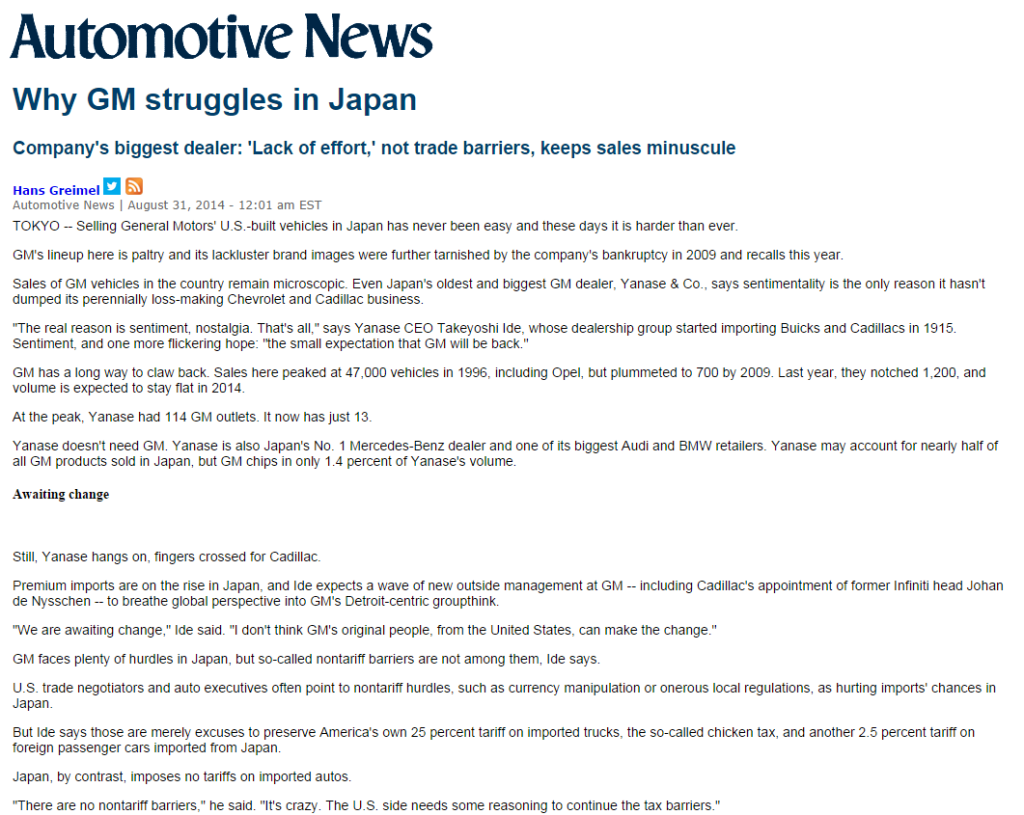By Hans Greimel
August 31, 2014
TOKYO — Selling General Motors’ U.S.-built vehicles in Japan has never been easy and these days it is harder than ever.
GM’s lineup here is paltry and its lackluster brand images were further tarnished by the company’s bankruptcy in 2009 and recalls this year.
Sales of GM vehicles in the country remain microscopic. Even Japan’s oldest and biggest GM dealer, Yanase & Co., says sentimentality is the only reason it hasn’t dumped its perennially loss-making Chevrolet and Cadillac business.
“The real reason is sentiment, nostalgia. That’s all,” says Yanase CEO Takeyoshi Ide, whose dealership group started importing Buicks and Cadillacs in 1915. Sentiment, and one more flickering hope: “the small expectation that GM will be back.”
GM has a long way to claw back. Sales here peaked at 47,000 vehicles in 1996, including Opel, but plummeted to 700 by 2009. Last year, they notched 1,200, and volume is expected to stay flat in 2014.
At the peak, Yanase had 114 GM outlets. It now has just 13.
Yanase doesn’t need GM. Yanase is also Japan’s No. 1 Mercedes-Benz dealer and one of its biggest Audi and BMW retailers. Yanase may account for nearly half of all GM products sold in Japan, but GM chips in only 1.4 percent of Yanase’s volume.
Awaiting change
Still, Yanase hangs on, fingers crossed for Cadillac.
Premium imports are on the rise in Japan, and Ide expects a wave of new outside management at GM — including Cadillac’s appointment of former Infiniti head Johan de Nysschen — to breathe global perspective into GM’s Detroit-centric groupthink.
“We are awaiting change,” Ide said. “I don’t think GM’s original people, from the United States, can make the change.”
GM faces plenty of hurdles in Japan, but so-called nontariff barriers are not among them, Ide says.
U.S. trade negotiators and auto executives often point to nontariff hurdles, such as currency manipulation or onerous local regulations, as hurting imports’ chances in Japan.
But Ide says those are merely excuses to preserve America’s own 25 percent tariff on imported trucks, the so-called chicken tax, and another 2.5 percent tariff on foreign passenger cars imported from Japan.
Japan, by contrast, imposes no tariffs on imported autos.
“There are no nontariff barriers,” he said. “It’s crazy. The U.S. side needs some reasoning to continue the tax barriers.”
The German brands have flourished in Japan, even as the Detroit 3’s fortunes fade. Their downfall, says Ide: “lack of effort.”
Case in point: GM’s dearth of right-hand-drive vehicles configured to Japanese roads. The Chevrolet lineup here has just two right-hand-drive vehicles, the Sonic small car and Captiva compact crossover, while the premium Cadillac line has none.
“We have some customers who are interested in GM cars, but it’s a big turnoff,” Ide said. “We are waiting for right-hand drive. They have already officially announced that Cadillac is a global model. A global model means it will be sold in various markets globally. That means they need to develop right-hand drive.”
Until then, Ide says he has folded Yanase’s shrinking GM business into Yanase’s used-car unit to subsidize its losses.
GM is aware of the need for right-hand-drive Cadillacs in Japan, but declines to talk future product plans. Import rivals from Europe have long offered a large selection of right-handers.
GM’s hands are partly tied by history.
From their early days, German and Japanese automakers built at home and shipped overseas to penetrate foreign markets. American brands, by contrast, built overseas factories to expand abroad.
GM has factories in right-hand-drive countries, but their vehicles often don’t fit Japan. Australia’s passenger cars are too big; South Africa churns out mostly trucks; England’s small cars find it hard to compete in Japan’s crowded small-car market. India’s operations are just getting started.
GM doesn’t sell Cadillac in any major right-hand-drive nation — except Japan, still the world’s No. 3 auto market.
Counting on Cadillac?
It’s a chicken-and-egg problem. It’s often not worthwhile to introduce a right-hand-drive version because sales are so low. And sales are so low in part because there are no right-handers.
Ide laid out some sobering math for GM’s 34 outlets in Japan. Even if nationwide GM sales climb to 1,400 units, that translates to annual sales of just 41 units per outlet.
At an average sticker of $50,000, that would generate revenue around ¥200 million ($1.92 million), plus service income. That’s far short of the ¥1 billion ($9.6 million) he said is needed to support an outlet with a showroom and garage.
“Do you think we can maintain it on 40 units?” he asks.
Still, Ide is optimistic. Perhaps overly so.
“If they would develop proper models suitable to the Japanese market, with right-hand drive, having sales of 5,000 units is not so difficult,” Ide postulated for GM’s full portfolio.
Japan’s domestic auto market has been in steady decline for nearly two decades. But passenger vehicle volume climbed 9 percent to 2.71 million units through July.
High-end brands, including Mercedes, Audi and BMW, all posted gains for the first seven months. Mercedes topped its German rivals, selling 31,291 vehicles. Yet, Cadillac remains a different animal: Its sales dropped 27 percent to 425.
Original Source: Automotive News
Click to view PDF:


